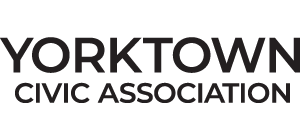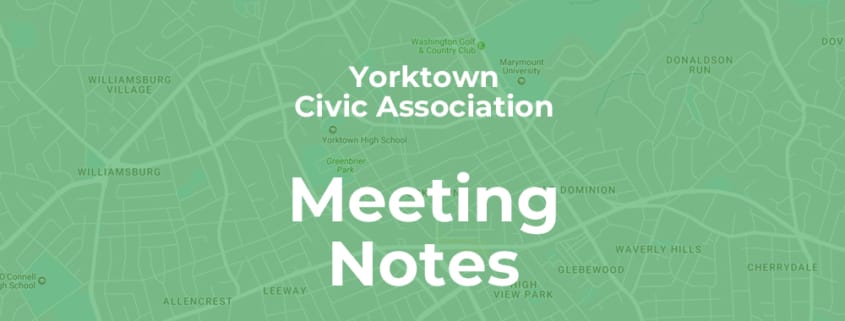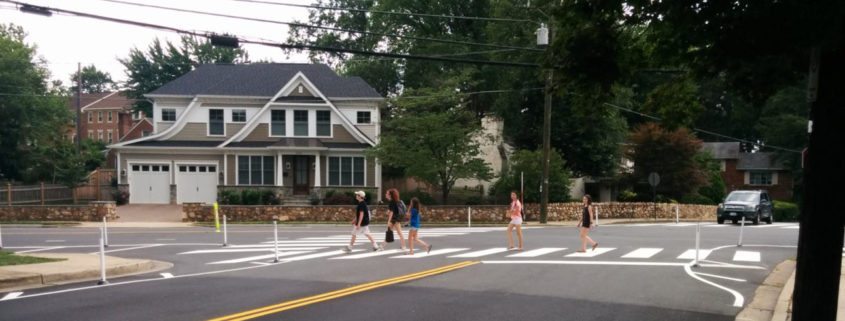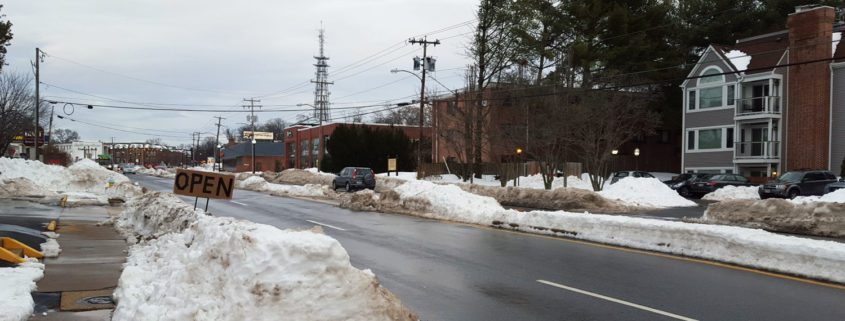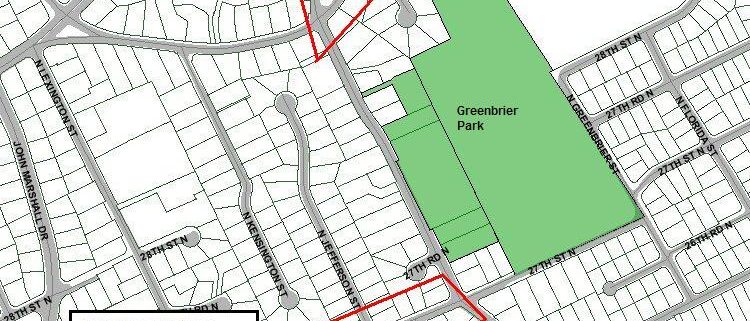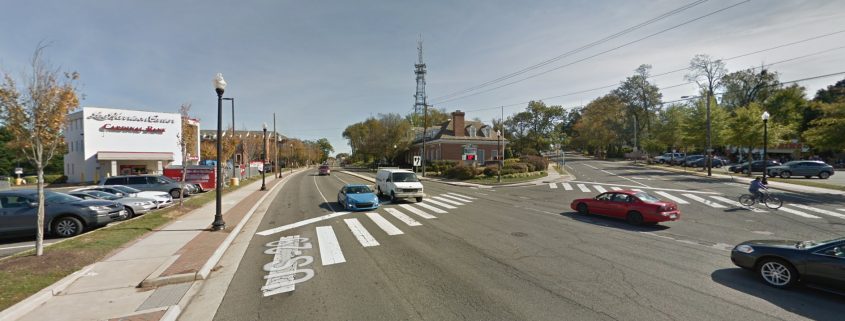Little Falls Road between N. Harrison St. and N. Lexington St. to Receive Traffic Calming AssistanceNotice: The next working group meeting on this project is scheduled for Monday, Nov. 3, 2003, at Little Falls Church. Affected residents are encouraged to attend.
On August 6th, 2003, Little Falls Road from Harrison Street west to Lexington Street was declared to be eligible to receive traffic calming assistance through the Arlington County Neighborhood Traffic Calming Program. This declaration was made by the County’s Neighborhood Traffic Calming Committee (NTCC) based on studies of current speeding and other traffic conditions on this street.
The east half of this street segment falls within the Yorktown Civic Association boundaries, while the west end forms the boundary between the Williamsburg (south side of the street) and Rock Spring (north side) civic associations.
The project is being staffed by Jeff Sikes (703/228-3696) of the Arlington County Public Works Department. Feel free to contact Jeff for additional information.
The following notes on developments to-date have been posted on the Williamsburg Civic Association’s website by Williamsburg President Ellen Jones:
Initial Information Meeting: The first neighborhood meeting on the project was held on September 22nd, 2003, at 7:30 PM in the Little Falls Church Small Dining Room. This was a concept meeting to explore possible options for the street. Jeff Sikes, from the County’s Neighborhood Traffic Calming staff, hosted the meeting. Don Gross, Williamsburg Vice President, attended the meeting, as did some of the near neighbors and the President of the Yorktown Civic Association.
Mr. Sikes explained that the street qualifies for traffic calming attention since the 85%ile speed is 33 miles per hour. There are about 2300 cars per day, 1500 going east (from the yield sign right toward the four-way stop on Harrison Street).
The discussion centered around various measures to slow the traffic:
The attendees from the Traffic Calming office recommend speed cushions. Some of the neighbors, however, oppose this option, arguing that it wouldn’t cut down the speed and was unsightly.
One suggestion that all seemed to think would help was to block the right turn yield and force motorists to make a hard right on the far side of the island.
The other measure that garnered approval from most participants was to put imprinted crosswalks at the four-way stop intersection on Harrison Street.
Some neighbors – noting that many motorists fail to stop at the four-way stop sign at the corner of Harrison and Little Falls – favor replacing the four-way stop with a traffic circle. However, some residents from the Yorktown side had lobbied hard for a four-way stop and might oppose this change. Moreover, because of the angle of the intersection, the County’s traffic calmers weren’t sure a traffic circle is feasible.
The County Traffic Calming office promised to investigate the feasibility of these suggestions.
Follow-On Neighborhood Meeting: The second neighborhood meeting of the Little Falls East Working Group was held on 7 October, 2003. Participants included the WCA President and Vice President; David Haring, President of neighboring Yorktown Civic Association, two representatives of the Neighborhood Traffic Calming Committee, and five residents from the project area.
Jeff Sikes, from the County Staff, presented his recommendations for traffic calming.
Reconfiguration of the existing traffic island where Little Falls and Yorktown meet, to force cars traveling east to make a hard right turn. This option would not injure the Dawn Redwood (a large conifer) on the island. This would involve changes to two driveways. Participants expressed support for this approach.
Installation of two speed cushions between the reconfigured turn and the intersection of Harrison Street and Little Falls. Although Mr. Sikes made a spirited defense of speed humps as the most cost-effective way to slow traffic, meeting participants were largely unconvinced, with a few favoring speed cushions and the rest opposed.
Installation of a traffic circle at the Harrison-Little Falls intersection, with crosswalks. The Little Falls residents expressed opposition to this option, since it entailed removal of the four-way stop sign. The alternative they suggested was to leave the four-way stop but install textured, at-grade cross walks. Mr. Sikes suggested the possibility of nubs to improve pedestrian safety. Several residents favored raised crosswalks, but Mr. Sikes indicated that these are not an option because the street is a fire response route.
Residents proposed a two-phased project: installation of the improvements at both ends of the street (see options 1 and 3, above), with the humps as a contingency, if the first phase does not solve the speeding problem. Mr. Sikes and the NTCC representatives had some problems with this approach, because it had not been done before. Mr. Sikes will poll the Neighborhood Traffic Calming Committee to see whether a phased approach is viable from a bureaucratic standpoint.
Third Neighborhood Meeting: The third meeting of the Little Falls East Working Group was held on 22 October 2003. Attendees included Mr. Sikes, two representatives from the Neighborhood Traffic Calming Committee, the President of the Yorktown Civic Association, the President of the Williamsburg Civic Association, and seven residents.
Mr. Sikes began the meeting by reviewing the two-phased project summarized above.
The proposal to reconfigure the traffic island at the intersection of Little Falls and Yorktown provoked a spirited discussion. Several of the residents most closely affected by this reconfiguration expressed reservations, as did the Yorktown Executive Committee. Questions were raised as to whether the narrow access road for the two driveways would be plowed in the winter. Some participants also thought that the strip of unused roadway used by two homes to access their driveways would be quite ugly.
Mr. Sikes, supported by the participants who opposed the traffic island reconfiguration, reiterated his proposal to add two to three speed cushions around 350 to 400 feet apart. He stated that the County has about 100 speed cushions in place and had found this option to be a very cost effective way to lower speeds from over 35 mph to under 30 mph. The speed cushions would also be installed sooner than intersection/traffic island work. Speed cushions normally are installed within a year of approval, while intersection work takes two years. A lively debate ensued. In response to a question, Mr. Sikes assured participants that the speed cushions would be installed in such a way as to allow vehicles to go over at the posted speed limit of 25 mph, without undue jostling of car or driver, unlike those which have been installed on Little Falls Road near O’Connell High School (which are scheduled to be reworked or reinstalled, since they don’t meet County specifications).
The proposal to install textured, at-grade crosswalks at the intersection of Harrison and Little Falls fared better. Most participants liked the idea, which entails retaining the four way stop signs. Mr. Sikes’ proposal to add nubs to narrow the street at three corners (providing a better pedestrian haven for crossing the streets) also garnered support.
Mr. Sikes was not able to provide a clear-cut answer to the question as to whether a phased approach (as described above) would be acceptable to the Neighborhood Traffic Calming Committee. He reported that there was a precedent for this approach, but that some Committee members opposed it.
Participants suggested several alternative approaches:
Yorktown Civic Association suggested the replacement of the current yield sign at the traffic island at the intersection of Little Falls and Yorktown with a stop sign. Mr. Sikes rejected this option, because the County has not approved stop signs as a speed control tool.
Mr. Sikes suggested an alternative to blocking off the traffic island at Yorktown and Little Falls completely. He suggested that the entrance points to the little strip of roadway be narrowed on both sides, creating a driveway type entrance which would deter east-going traffic from using it and encouraging these vehicles to go further up Yorktown and make a hard right onto Little Falls. He suggested that residents might want to check out the intersection of 17th and Hartford, which incorporates a similar driveway type entrance. This suggestion garnered somewhat more support than the initial idea of closing off the traffic island road completely.
The Working Group is now looking at two options:
A reconfigured traffic island at Little Falls and Yorktown, a reconfigured intersection (with nubs) at Harrison and Little Falls in the first stage, with the option to install speed cushions if these measures fail. This option was supported by several residents who attended the second meeting.
A reconfigured intersection (with nubs) at Harrison and Little Falls plus three speed cushions about 350-400 feet apart. This option was supported by several meeting participants, including those residents who opposed the reconfiguration of the Little Falls/Yorktown traffic island.
We need to come to a consensus within the next few weeks, since the petitions need to be done in December to meet NTCC’s calendar. Sixty percent of the affected households must approve the petitions. The NTCC would also like the three affected civic associations (Williamsburg, Yorktown, and Rock Spring) to endorse the project; NTCC looks more kindly on projects that have civic association approval.
The next meeting of the Little Falls East Working Group is Monday, 3 November 2003, at 7:30 at Little Falls Church. We will meet in the Library, which is on the main floor of the church. Look for the signs. All residents of Little Falls from Yorktown to Harrison should make an effort to attend this meeting, since we will be trying again to reach consensus (hopefully one that the neighbors most directly affected can live with!), and draw up an agreed-upon language for the neighborhood petition.
